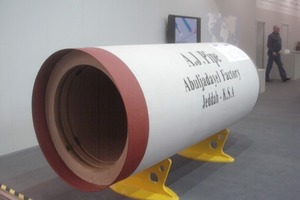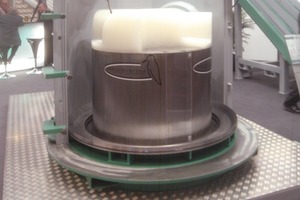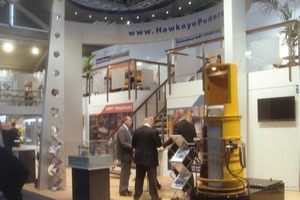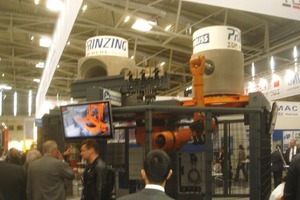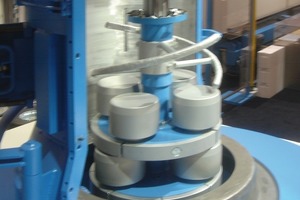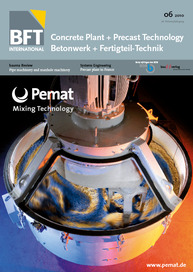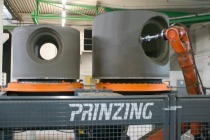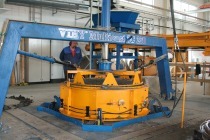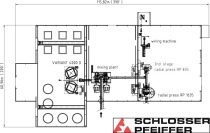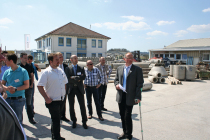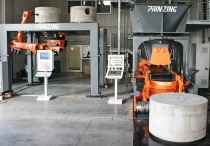Pipe machinery and manhole machinery
This year’s bauma started with several question marks: Would the exhibitors respond with strict austerity programs to the crisis also when it comes to their trade fair presence? In this respect, the answer is a clear no. Here and there the number of exhibits was reduced; however, the presences on the whole were as prestigious as always. Have the austerity programs hindered the development and thus reduced the capacity for innovations? Here the answer is also a very clear no, on the contrary, there were striking innovations to be seen.
And last but not least: how would the ban on flights over Europe affect the especially export-oriented manufacturers of pipe and manhole machinery? Unfortunately, this was reflected at least for the first days of the trade fair, however, exhibitors in general were confident that the specific projects could then be realized after the bauma in turn. The flying ban was luckily lifted still during the bauma, so that the foreign exhibitors were yet in the position to complete their teams at the booth. The following part gives a review of some manufacturers and their exhibition programs (note from the editor: the article does not claim to be complete).
Besser - Omag
Owing to the sales programs of the two companies they have a very wide range of pipe machinery available: The
BiDi® comes from the product range of Besser. The name stands for bidirectional (moving in two directions) and refers to the direction of rotation of the spreading level and the compaction level in the rollerhead, thus already describing this machine type. It is a high-performance machine called A 60 with the type designation standing for the dimension (60 inch, i.e. for pipes up to diameters of approx. DN 1500). The cycle time is ranging below 1 minute per pipe for smaller diameters. The machine is equipped as standard with 2 separate hydraulic systems for the two rollerhead levels so as to provide an optimum adaptation of the two torques when spreading and pre-compacting, on the one hand, and the final compaction and smoothing, on the other hand.
In addition to the manufacturing machine, the company has developed together with the German section, and owing to the acquisition of Messmann, a complete transport system as moving-floor system. A special feature is the drive of the feed motion by means of hydraulic motors that is to ensure a very gentle transport.
The well-proven underground machines with core vibration come from the range of Omag, as the R 120/120 being a machine for manhole rings as well as the R 250/120 as a pipe machine. The pipe with PVC liner exhibited was produced on this machine, a product that can only be manufactured on core machines but not on rollerhead machines. (Fig. 1)
B+S GmbH
Here, in particular, the further development for the production of manhole base sections with channel was of interest: an industrial robot mills the channel negative from a solid body, thus an approach similar to BFS. Contrary to this, the body, however, is made of wax so that it can be recycled in the concrete plant without any problems, in fact for both the milling waste and the pieces of the negative mold after demolding (Fig. 3). However, a special note should be made on the fact that this method requires a certain expenditure of energy for melting down the wax when recycling the same and the production of the solid body respectively.
The finished molding is preferably used for the production with SCC, however, production in casting molds with external vibrators or internal spud vibrators is also possible. Only the application of earth-moist concrete is rather considered skeptically in case of immediate demolding, presumably the vibration forces required here are a bit too intensive for the mold bodies.
BFS – Casagrande
Here two machinery types are especially interesting:
This type has been converted to an electric drive system for the rollerhead some years ago. Some of them have now been in operation for several years so it is justified to claim that there is sufficient experience in this field now. This is quite obviously on the positive side because the electric drive is used as standard equipment and hydraulic, for instance, is not even offered as an option.
In this regard, BFS has chosen a very innovative approach as it can also be seen elsewhere in a modified version: The mold of the channel negative is milled out of the solid body. This body consists of EPS or bonded sand thus it is possible to recycle both the milling waste and the channel negative after finishing the production process. Manufacturing the negative in one piece provides for downright smooth and round joints. The manhole base sections
(Fig. 2) are manufactured of self-compacting concrete in molds. Programming of the milling robot is most user-friendly – the relevant data, such as quantity, diameter, position of inlets and outlets, are entered, the software does the rest showing at first the complete design of the channel that may be approved by the customer.
Colle – Wagener & Polascheck
The company provided information on the overall sales program comprising:
» The rollerhead machine Turbomaster: In this case, the rollerhead is electric motor driven, however contrary to the machine of BFS with a drive motor. A gear drive provides for the bidirectional running between compaction and smoothing level.
» Main item of the product range is the Vibromatic, a machine with upright core for a maximum production size of 2.5 m diameter at a maximum overall length of 3 m. The kind of filling is a novelty here. The center of each pipe is always fed even in case of double or triple manufacturing so as to ensure an optimum uniformity of the products.
» The Vimatic is the machine for large sizes, i.e. of up to pipe diameters of 3 m and frame elements of 2.5 x 2.5 m respectively. Furthermore, this machine is also able to manufacture cones, manhole rings and – owing to a supplemented turning unit – tanks and three-chamber sewage plants.
The product range is complemented by casting molds, transport systems for pallets and cured pipes as well as a modular system for frame elements.
HawkeyePedershaab
A novelty at the trade fair was the high-performance Mastermatic with a capacity of 44 pipes of diameters from DN 300 to 600 per hour: In this case, the so far existing crucial disadvantage of a machine with a rising core contrary to a rollerhead machine – the remarkably longer time needed for dimensional changes – has been eliminated. Due to the new quick mold exchange system molds can be changed in just 30 minutes per side.
There are two different machines and/or equipment available in the sales program for manufacturing manhole rings:
» Smartcast for the casting method with self-compacting concrete. This is in particular intended for manhole base sections with channel, with the negative form pieces milled.
» Kastmaster for the production with earth-moist concrete and immediate demolding, thus for larger quantities.
In addition to this, the company has designed a cage welding machine.
Prinzing
This trade fair presence was also completely dominated by the production of manhole base sections with channel, whereas here an entirely different but all the same highly interesting approach was chosen: Instead of manufacturing separate mold bodies for the channel, the manhole base sections are manufactured as a complete concrete body with base unit of an adequate thickness and milled when semi-hardened. In this process, both the openings on the side and the channel are milled into the concrete. This, of course, requires different kinds of tools – the robot carries out the necessary tool change fully automatically. The associated user-friendly software allows, as for the other systems described, a customer-specific entry of the channel parameters in a simple way issuing the corresponding illustration of the final product simultaneously.
For this method it is important to choose the correct point in time for processing because when processing starts to early the edges may frazzle and too long hardening might have a negative impact on tool wear. Surprisingly the subject of tool wear is not a cost factor at all: now, manufacturing experience could be gained over a period of 2 ½ years and the robot used is still working with the first set of tools.
The time factor is quite related to practice too: for an assumed quantity of 20 manhole base sections manufacturing of the green bodies requires approx. 3 hours, under usual weather conditions it is possible to start milling already after approx. 4 h enabling the same worker, who has at first produced the rough casts, to carry out the processing work of the same thereafter. As processing time takes somewhat longer than manufacturing, the hardening time is a little bit longer for the last elements, but anyhow well within the tolerance of the permissible time frame. This really innovative method is brought to the market under the name „Primuss“. In the factory, the mold bodies are either placed at floor level or slightly higher; the robot is placed below floor. The chosen arrangement was only used for exhibition purposes (Fig. 5)
Schlosser - Pfeiffer
It goes without saying that they were represented at the booth as being a subsidiary company of the Hess Group. The completely reengineered radial press was one of the highlights of this presentation. The further development aimed at the aspects: ease of manufacturing, ease of transport, ease of installation, ease of operation. For these reasons, design now has entirely been adjusted to the appropriate manufacturing facilities of the plant in Burbach so that production will only be carried out there in future and moreover under utmost efficient conditions.
The pre-assembled machine fits on a 40“ flatbed. The fact that delivery can be effected in a pre-assembled state results in very short and thus cost-efficient installation. The diagrams visualizing the control system have been redesigned – all distance, time and pressure data is now given in absolute figures and in the respective dimension so as to provide really comprehensible manufacturing parameters to the operator.
The actual highlight of the new machine RP 1225-4, however, is the fully automatic quick change system of the rollerhead (Fig. 6). It is not only the time effect that is essential here as so far it has already been possible to change the rollerhead relatively fast at least for smaller dimensions. But in fact it is conceivable now to manufacture a pipe with two different concrete grades in a single workstep with two rollerheads having just slightly different diameters – a so-called composite pipe. This provides a real alternative to pipes with plastic lining. Schlosser – Pfeiffer holds already a patent for such a manufacturing method and, of course, has filed for patent also the current equipment.
Schlüsselbauer Technology GmbH & Co. KG
Apart from the new pipe system Perfect Pipe+ the company displayed the individual Perfect manhole base sections and the associated manufacturing system that are already well-known from bauma 2004 and 2007 respectively. The highlight at this booth was a manhole base having a diameter of DN 1500 made of high-performance concrete that enables the connection of pipes of nominal diameters of up to DN 1000. The Perfect manhole displayed at the exhibition was already connected with pipes of the new system Perfect Pipe+ having nominal diameters of DN 200 and DN 400.
Summary
Bauma 2010 presented real novelties and that for both pipe and manhole manufacturing with, in particular, the latter surprising with a variety of intelligent and quite different solutions in terms of the approach. It will be interesting to notice whether a particular method of manufacturing the channel will prevail or whether several ones will exist side-by-side. The proof is anyhow encouraging that the machine construction sector has demonstrated its ability to innovate also in times of the crisis and carried out research and development despite all cost-cutting measures.

